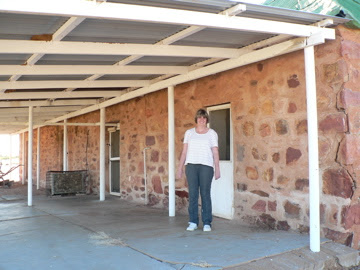After a morning’s backbreaking labour, panning, we came away with a washing machine full of red-dyed clothes and a small handful of gorgeous garnets, some of good size, that we left to be cut and polished into what panned out to be a pair of very expensive Christmas gifts for the girls. Tho’ the insurable value of the soon-to-be-finished pieces of jewellry is meant to take away some of the pain. But ouch!
 |
| Panning like a pro |
Gemtree is a wonderful bush camp with a natural earth airstrip onsite and a red clay and tussock-grass golf course for players of red-dirt golf. There is a 'donkey' hot water system where water is running through coils in 44 gallon drums and heated by throwing small branches of wood underneath, at regular intervals during the day. If the job is forgotten the water goes cold. When we needed it the water was skin-stripping hot, and the toilet paper so soft. Such simple things, such welcome luxuries: but what more could a body want.
We took long bush walks in the late afternoon and early morning and found great arid-country specimens of flora and fauna. A surprise sighting of a rare Grey Falcon had our blood pressure pumping; as did a high-flying Black Breasted Buzzard with its rufous bits and glorious prominent white bull’s eye patches under its wings.
On the ground we found gnarled corkwood with its deeply furrowed trunk like a heavy duty tire tread; and Dead Finish, that vicious spiky bush with its grim bush humour name implying that before this plant completely dies out all others will have long gone before.
 |
| Dead Finish, alive and well |
We came across a cluster of delightful mulga ants nests built like tiny medieval red-earth sandcastles, with an inner hollowed-out bailey courtyard, encircled by high protective red-earth barricades of sand – to protect the ant colony from a deadly rainwater run-off death in times of wet in this concrete-hard land. These were the home of large black ants, tirelessly winding their way back home, each carrying a thin needle of mulga leaf in their jaws, twice their size, to lay as a meticulously-neat decorative camouflage atop their red earth castle barricades.
We head home to barbecue sticky pork ribs in the cool of the evening and probe a native bush banana vine growing on barren tendrils at the base of a trunk near our campsite.
'Gems' everywhere, here.
 |
| Built like a medieval barricade |
oooOOOooo






















